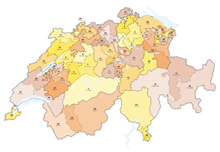1896 Swiss federal election
Federal elections were held in Switzerland on 25 October 1896. The Free Democratic Party retained its majority in the National Council.[1]
.svg.png) |
|---|
| This article is part of a series on the politics and government of Switzerland |
|
|

The 52 electoral districts
Electoral system
The 147 members of the National Council were elected in 52 single- and multi-member constituencies using a three-round system. Candidates had to receive a majority in the first or second round to be elected; if it went to a third round, only a plurality was required. Voters could cast as many votes as there were seats in their constituency.[2] There was one seat for every 20,000 citizens, with seats allocated to cantons in proportion to their population.[2]
Results
Voter turnout was highest in Nidwalden at 90.3% (higher than the 89.3% in Schaffhausen where voting was compulsory) and lowest in Obwalden at 21.4%.
| Party | Votes | % | Seats | +/– |
|---|---|---|---|---|
| Free Democratic Party | 181,028 | 48.7 | 86 | +12 |
| Catholic People's Party | 85,484 | 23.0 | 30 | +1 |
| Liberal Centre | 54,012 | 14.5 | 21 | –6 |
| Social Democratic Party | 25,304 | 6.8 | 2 | +1 |
| Democratic Group | 19,946 | 5.4 | 8 | –8 |
| Others | 5,750 | 0.0 | 0 | 0 |
| Invalid/blank votes | 26,701 | – | – | – |
| Total | 398,625 | 100 | 147 | 0 |
| Registered voters/turnout | 713,367 | 55.9 | – | – |
| Source: Mackie & Rose,[3] BFS (seats) | ||||
gollark: ```lua print "Press any key to reboot. Press u to update." local timer = os.startTimer(10) local _, k = os.pullEvent "key" if key == keys.q or key == keys.u then os.reboot() else install() end```
gollark: I just found out that an important bit of the code was entirely wrong.
gollark: * logging
gollark: PotatoS really needs bettererrerer login.
gollark: I'm actually updating the potatOS sandbox initialization logic now to [REDACTED].
References
- Elections to the National Council 1848–1917: Distribution of seats by party or political orientation Archived 2015-09-23 at the Wayback Machine BFS
- Dieter Nohlen & Philip Stöver (2010) Elections in Europe: A data handbook, p1886 ISBN 9783832956097
- Thomas T Mackie & Richard Rose (1991) The International Almanac of Electoral History, Macmillan
This article is issued from Wikipedia. The text is licensed under Creative Commons - Attribution - Sharealike. Additional terms may apply for the media files.